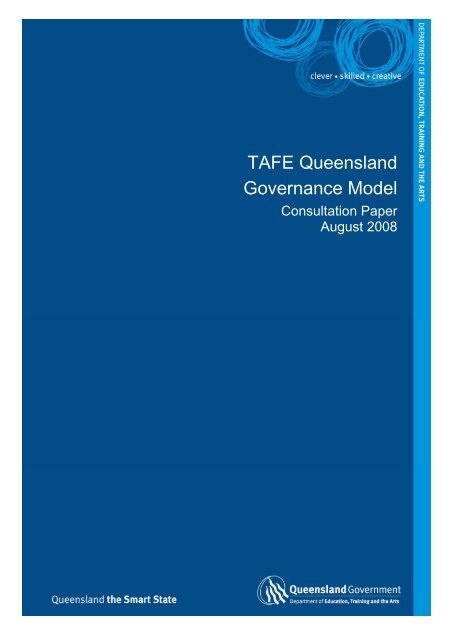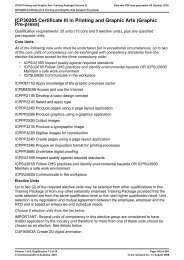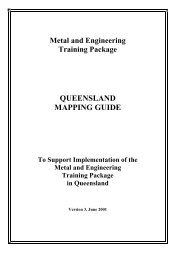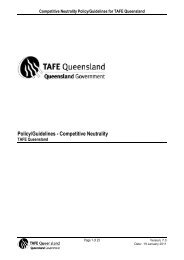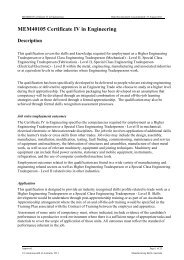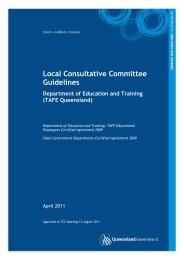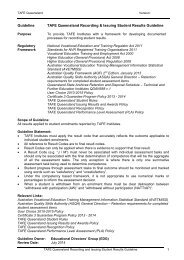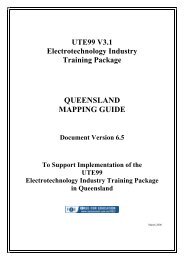TAFE Queensland Governance Model Consultation Paper [PDF ...
TAFE Queensland Governance Model Consultation Paper [PDF ...
TAFE Queensland Governance Model Consultation Paper [PDF ...
- No tags were found...
Create successful ePaper yourself
Turn your PDF publications into a flip-book with our unique Google optimized e-Paper software.
<strong>TAFE</strong> <strong>Queensland</strong><strong>Governance</strong> <strong>Model</strong><strong>Consultation</strong> <strong>Paper</strong>August 2008
Message from the Minister<strong>Queensland</strong>’s workforce, industry and economy continue to develop and change. Jobs andindustries unheard of five years ago are emerging with unique training needs and demandfor skills in <strong>Queensland</strong> continues to grow at unprecedented rates.<strong>Queensland</strong>’s vocational education and training system must remain responsive to thesechanges, be flexible enough to offer solutions and ensure public and private training sectorgrowth to support the state’s rapid economic expansion.The 2006 <strong>Queensland</strong> Skills Plan acknowledged that the rapidly changing training marketposed real challenges for the responsiveness of the current <strong>TAFE</strong> delivery model. It outlinedthe need to revitalise the <strong>TAFE</strong> system to enable more flexibility and greater responsivenessto industry and business needs.Ensuring we have a vibrant and robust public training provider, alongside a thriving privatesector, is the cornerstone in ensuring the skills of <strong>Queensland</strong>’s workforce matches theneeds of industry and our vocational education and training system remains world-class.In partnership with industry and employers, we have made considerable progress inimplementing the 24 actions of the <strong>Queensland</strong> Skills Plan designed to create a modern andresponsive training system that meets the skilling needs of industry, individuals andemployers.In 2008, as part of the <strong>Queensland</strong> Skills Plan initiatives to revitalise <strong>TAFE</strong>, SouthbankInstitute of Technology and Gold Coast Institute of <strong>TAFE</strong> have been established as statutory<strong>TAFE</strong> institutes providing flexibility and responsiveness at the local level to respond toemerging business and industry needs.It is now our responsibility to consider a governance model for the <strong>TAFE</strong> system for thefuture that will best meet <strong>Queensland</strong>’s training needs — including industry, employers,workers and learners.Rod Welford MPMinister for Education and TrainingMinister for the Arts
Table of ContentsWhy does our <strong>TAFE</strong> system need to change? ........................................................................................1What is this paper for?.............................................................................................................................2Guidelines for making a submission........................................................................................................2Who should make a submission? .......................................................................................................2How to make a submission.................................................................................................................3Contacts .............................................................................................................................................3<strong>Queensland</strong> Skills Plan............................................................................................................................4A training system to support our growing state........................................................................................4What has already been done?.................................................................................................................4Commercial <strong>Governance</strong> <strong>Model</strong> .........................................................................................................4Legislation ..........................................................................................................................................5Southbank Institute of Technology .....................................................................................................5Gold Coast Institute of <strong>TAFE</strong> ..............................................................................................................5What are the benefits of changing to a statutory authority model? .....................................................5A <strong>TAFE</strong> <strong>Queensland</strong> model for the future................................................................................................6Initial consultation ...............................................................................................................................6<strong>Model</strong> development ............................................................................................................................7<strong>Governance</strong> models considered .........................................................................................................8Meta model: Metropolitan and near metropolitan options ..............................................................8Meta model: SkillsTech Australia...................................................................................................8Meta model: Regional options .......................................................................................................9Considerations for the governance model ..........................................................................................9Consideration of the national agenda ...............................................................................................10Where to from here? .............................................................................................................................11Recommended <strong>TAFE</strong> <strong>Queensland</strong> <strong>Governance</strong> <strong>Model</strong>....................................................................11Why are these changes being proposed now?.................................................................................12Future options...................................................................................................................................13Discussion points ..................................................................................................................................13Other information...................................................................................................................................14Process for becoming a statutory <strong>TAFE</strong> institute..............................................................................14When is an institute ready to transition? ...........................................................................................15How is the Board appointed?............................................................................................................15How is the Executive Officer appointed? ..........................................................................................16How can we be sure that the <strong>TAFE</strong> system will continue to deliver high-quality training?................16What are the checks and balances for the system? .........................................................................16Staffing arrangements - institute.......................................................................................................17Impact on departmental staff ............................................................................................................17Impact on students ...........................................................................................................................17Impact on industry ............................................................................................................................18<strong>TAFE</strong> community service obligations................................................................................................18Lead institutes ..................................................................................................................................18Teacher support networks ................................................................................................................18Will statutory <strong>TAFE</strong> institutes compete with each other?..................................................................18Next steps .............................................................................................................................................19Timelines ..........................................................................................................................................19
Why does our <strong>TAFE</strong> system need to change?The <strong>Queensland</strong> Government’s Smart State strategy is focused on creating a state whereknowledge, creativity and innovation drive economic growth to improve prosperity andquality of life for all <strong>Queensland</strong>ers. The Smart State strategy identifies the need to invest inpeople, creativity and innovation, partnerships and collaboration, while maintaining a futurefocus.The <strong>Queensland</strong> <strong>TAFE</strong> system must support a diversified knowledge-based economy alongwith our traditional economic base to ensure <strong>Queensland</strong> has the people with the skills andqualifications for the jobs of tomorrow.<strong>Queensland</strong> industry is continuing to report skills shortages. There are many reasons forskills shortages, including rapid changes in the population and labour market. However,these factors will have less impact on the availability of skilled labour if the education andtraining systems are more closely aligned to the needs of students, industry and thecommunity.<strong>Queensland</strong>’s <strong>TAFE</strong> system must be enabled to effectively collaborate with industry todiversify and expand training opportunities and provide training that matches current andanticipated workforce requirements. We need to move from a supply driven training systemto a system that can respond rapidly to changes in market demand for skills.Within our regional communities, <strong>Queensland</strong>’s individual <strong>TAFE</strong>s are ideally placed to buildon the strengths of local relationships and provide real partnerships for local economicdevelopment. Within metropolitan areas, <strong>TAFE</strong> must be positioned to address the needs ofkey segments in a highly competitive market.To support the <strong>Queensland</strong> Government’s vision for a Smart State we must also provide forprivate and public sector growth in the vocational educational and training sector. The<strong>Queensland</strong> Government is committed to ensuring a vibrant and robust public trainingprovider equipped to develop training capacity and capability to best meet the needs ofindividuals, industry and communities.Statutory <strong>TAFE</strong> institutes are enabled with the autonomy and business acuity to meetcustomer needs, target new markets, and create a financially sustainable organisationdelivering the opportunity for surpluses to be reinvested at the institute level in staff andtraining facilities.1
What is this paper for?We are seeking your views about the proposed model for the organisation of the<strong>Queensland</strong> <strong>TAFE</strong> system for the future, including options for metropolitan institutes, nearmetropolitan institutes, SkillsTech Australia and regional reorganisation and alignments.Initial consultation on the future governance model for the <strong>TAFE</strong> <strong>Queensland</strong> system wasundertaken late in 2007, along with a more recent review and consideration of the manycritical external factors. The outcome is this <strong>TAFE</strong> <strong>Queensland</strong> <strong>Governance</strong> <strong>Model</strong><strong>Consultation</strong> <strong>Paper</strong>. The <strong>Consultation</strong> <strong>Paper</strong> documents the important considerations for thefuture of the system, presents models that could be adopted for the <strong>TAFE</strong> <strong>Queensland</strong>system and recommends a specific model.We want to hear what you think about the recommended governance model for the <strong>TAFE</strong><strong>Queensland</strong> system and its ability to deliver on <strong>Queensland</strong>’s training needs for our state’sfuture. Your views are important and will help improve our <strong>TAFE</strong> system to ensure it is thebest in Australia.Guidelines for making a submissionWho should make a submission?The Department of Education, Training and the Arts welcomes comments on this<strong>Consultation</strong> <strong>Paper</strong>. Anyone in the community with an interest in vocational education andtraining is invited to have their say about the model proposed here.Copies of this paper are available on the internet atwww.trainandemploy.qld.gov.au/skillsplanPlease share it with interested parties.2
How to make a submissionThere is no specified format for submission. Submissions may range from a responseaddressing one issue to a systematic analysis of the proposed model. Submissions will beaccepted in a range of styles and in electronic or hard copy format, however, electronicformat is preferred. See the Contacts section below for submission details.Submissions received will be available for use within the Department of Education, Trainingand the Arts. The <strong>Consultation</strong> <strong>Paper</strong> outcomes report will list the names of all those whomade submissions. Please mark your submission as ‘CONFIDENTIAL’ if you do not wantyour name listed as having made a submission. Your submission will be registered ashaving been received with a submission number and the word ‘confidential’.Responses to this <strong>Consultation</strong> <strong>Paper</strong> should be received by Monday 1 September 2008.Please refer to the section titled Discussion points for further information.ContactsEmail for enquiries or submissionsPostal address for submissions<strong>TAFE</strong><strong>Governance</strong>@deta.qld.gov.au<strong>TAFE</strong> <strong>Governance</strong> Project – <strong>Consultation</strong> <strong>Paper</strong>Department of Education, Training and the ArtsLevel 4, 30 Mary StreetLMB 527Brisbane QLD 40013
<strong>Queensland</strong> Skills PlanAfter consultations between government, industry associations, unions, registered trainingorganisations and community members across <strong>Queensland</strong>, the <strong>Queensland</strong> Skills Plan waslaunched in March 2006.The <strong>Queensland</strong> Skills Plan comprises 24 separate actions that are substantial systemicimprovements to vocational education and training, aimed at providing the skilled workforcethat will underpin the state’s future economic growth and prosperity.A training system to support our growing state<strong>Queensland</strong>’s vocational education and training system needs public and private sectorgrowth to support the state’s rapid economic expansion.The training system must be flexible, responsive and innovative to guarantee developmentthat matches the skilling needs of industry and individuals.In response to these challenges, the <strong>Queensland</strong> Skills Plan is reshaping our traininglandscape, including improving the way <strong>TAFE</strong> institutes operate.The <strong>Queensland</strong> Government is determined that <strong>TAFE</strong> institutes continue to play a majorrole in meeting <strong>Queensland</strong>’s skilling requirements. To achieve this, some key aspects of the<strong>TAFE</strong> <strong>Queensland</strong> system need to be changed.What has already been done?Commercial <strong>Governance</strong> <strong>Model</strong>Action 2 of the 2006 <strong>Queensland</strong> Skills Plan — Reforming the <strong>Queensland</strong> <strong>TAFE</strong> system —identified a move to more commercial governance arrangements for the <strong>TAFE</strong> system,alongside the development of a new model for industry engagement and the redirection ofresources to <strong>TAFE</strong> institutes.Commercial governance establishes a framework for operations that provides the flexibilityand responsiveness needed to compete in a commercial environment whilst maintaining anappropriate level of government control and oversight.4
The government considered a range of options to move <strong>TAFE</strong> to a more commercialgovernance model. The statutory authority model was considered to be the best balance ofoperational flexibility and autonomy with accountability and government training priorities.LegislationThe addition of Chapter 6A to the Vocational Education, Training and Employment Act 2000in November 2007 created a framework for the establishment and operation of <strong>TAFE</strong>institutes as statutory authorities, to be known as statutory <strong>TAFE</strong> institutes.Southbank Institute of TechnologyOn 1 April 2008, Southbank Institute of Technology was established as <strong>Queensland</strong>’s firststatutory institute in the <strong>Queensland</strong> <strong>TAFE</strong> network.Gold Coast Institute of <strong>TAFE</strong>On 1 July 2008, Gold Coast Institute of <strong>TAFE</strong> was established as a statutory <strong>TAFE</strong> institute.What are the benefits of changing to a statutory authority model?The primary objective of the statutory authority model is to establish more flexible, costeffective and autonomous governance arrangements, to enhance the capacity of <strong>TAFE</strong><strong>Queensland</strong> institutes to develop industry partnerships and grow the investment in training toprovide more training opportunities for <strong>Queensland</strong>.A vibrant and robust public provider will be ensured by providing statutory <strong>TAFE</strong> instituteswith the autonomy and business acuity to meet local customer needs, target new markets,improve training capacity, and create a financially sustainable organisation delivering theopportunity for surpluses to be reinvested at the institute level.A secondary objective of this model is to position <strong>TAFE</strong> institutes to enable eligible studentsto access Commonwealth VET FEE-HELP. Commonwealth VET FEE-HELP will beextended to assist full-fee paying vocational education and training students undertakingdiplomas and advanced diplomas, with a credit transfer arrangement toward a highereducation award, graduate diplomas and graduate certificates. To obtain VET FEE-HELPprovider approval under the Higher Education Support Act 2003 (Commonwealth), <strong>TAFE</strong>institutes are required to have body corporate status, which will be addressed byestablishing <strong>TAFE</strong> institutes as statutory authorities.5
While this work began as a result of the 2006 <strong>Queensland</strong> Skills Plan, the federal agenda tocreate a nationally competitive market with a suite of reforms, has now impacted on thecontext and timeframes for these initiatives. The <strong>Queensland</strong> <strong>TAFE</strong> system must beprepared for future participation in a nationally competitive and demand driven market.A <strong>TAFE</strong> <strong>Queensland</strong> model for the futureInitial consultationActions 3.3 and 3.4 of the 2006 <strong>Queensland</strong> Skills Plan respectively set the challenge toreorganise Brisbane metropolitan <strong>TAFE</strong> delivery and realign the structures of regional <strong>TAFE</strong>institutes to better meet the current and future needs of industry, employers, workers andlearners.At the <strong>TAFE</strong> Institute Council Chairs meeting in September 2007, a proposed model for<strong>TAFE</strong> <strong>Governance</strong>, as outlined in Action 2 of the 2006 <strong>Queensland</strong> Skills Plan, wasdiscussed in the context of the introduction of the enabling legislation and the anticipatedestablishment of Southbank Institute of Technology as a statutory authority.During October 2007, initial proposals and feedback were canvassed from <strong>TAFE</strong> institutes,their Chairs and Directors. A request for written feedback by early November 2007, wasdistributed to all <strong>TAFE</strong> institutes with a focus on: key considerations when developing amodel of governance for the <strong>TAFE</strong> system; specific institute considerations; anddevelopment of possible options. Context issues such as capacity, size and scope ofinstitute operations, duplication, board expertise, external drivers (eg. Federal Government),market positioning, stakeholder perceptions and the roll out of SkillsTech Australia were alsoconsidered. Responses were received from Barrier Reef, Brisbane North, Central<strong>Queensland</strong>, Metropolitan South, Mt Isa, Southern <strong>Queensland</strong>, The Bremer and TropicalNorth Institutes of <strong>TAFE</strong>. A combined response was received from The Bremer, SunshineCoast and Gold Coast Institutes of <strong>TAFE</strong> and SkillsTech Australia.Information gathered through the initial phase has informed the development of thegovernance models outlined here.6
<strong>Model</strong> developmentBased on initial consultation, the department has developed a number of models for the<strong>Queensland</strong> <strong>TAFE</strong> system as a whole, including options for metropolitan, near metropolitan,SkillsTech Australia and regional reorganisation.Driving intended 2006 <strong>Queensland</strong> Skills Plan outcomes has been a key consideration indevelopment of the models, including the ideals of Action 1, the move to commercialgovernance arrangements under Action 2 and the creation of SkillsTech Australia underAction 3.Various market and organisational segmentation methods were considered in developingthe proposed options such as:−Geographic (transport corridor, Training <strong>Queensland</strong> district model, Education<strong>Queensland</strong> district/regional model and national and international comparatives);−Customer demographics and customer type (corporate customers, school-based,mature age and life long learning);−Delivery model (face to face, blended, virtual real time and not real time);−Product delivered (nominated trades, higher level qualifications, further education); and−Industry-based analysis.7
<strong>Governance</strong> models consideredActions 2.2, 3.1, 3.3 and 3.4 of the 2006 <strong>Queensland</strong> Skills Plan respectively set thechallenge to move to commercial governance arrangements; create SkillsTech Australia;reorganise Brisbane metropolitan <strong>TAFE</strong> delivery; and realign the structures of regional<strong>TAFE</strong> institutes. As a result of these actions and requests from various <strong>TAFE</strong> Councils, thefollowing options have been explored in the context of, and under the framework providedby, Chapter 6A of the Vocational Education, Training and Employment Act 2000.Meta model: Metropolitan and near metropolitan optionsThe multiple options considered in relation to the metropolitan institutes of Brisbane NorthInstitute of <strong>TAFE</strong> and Metropolitan South Institute of <strong>TAFE</strong> and subsequently extended toinclude the near metropolitan institutes, Sunshine Coast Institute of <strong>TAFE</strong> and The BremerInstitute of <strong>TAFE</strong>, are summarised below and include:−the transition of all institutes to statutory authority status individually;−the amalgamation of various institutes either prior to or following the transition tostatutory authority status; and−the realignment of campuses between institutes.Meta model: SkillsTech AustraliaSkillsTech Australia has been created as a result of Action 3 of the <strong>Queensland</strong> Skills Planas the statewide trade and technical skills institute to lead product development and deliverythroughout <strong>Queensland</strong> for automotive, building and construction, manufacturing andengineering and electric/electronic studies.Currently, SkillsTech Australia manages the metropolitan training delivery formerlyundertaken by Brisbane North Institute of <strong>TAFE</strong>, Metropolitan South Institute of <strong>TAFE</strong> andSouthbank Institute of Technology. Subsequently, trades and technical training will transferin June 2009 from Gold Coast Institute of <strong>TAFE</strong> to SkillsTech Australia. Identified tradetraining from The Bremer Institute of <strong>TAFE</strong> and Sunshine Coast Institute of <strong>TAFE</strong> is alsoanticipated to follow.As part of the statewide system, SkillsTech Australia will transition to a statutory <strong>TAFE</strong>institute. In addition, through an identified SkillsTech regional entity it would then negotiatethe trade and technical training delivery with a proposed Regional <strong>Queensland</strong> statutory<strong>TAFE</strong> institute as detailed below.8
Meta model: Regional optionsThe options considered for the regional <strong>TAFE</strong> institutes of Tropical North <strong>Queensland</strong>,Mount Isa, Barrier Reef, Central <strong>Queensland</strong>, Wide Bay, and Southern <strong>Queensland</strong>Institutes of <strong>TAFE</strong> include:−the transition of all institutes to statutory authority status individually, represented by aBoard for each institute and individual interaction with SkillsTech Australia; and−the formation of a Regional <strong>Queensland</strong> statutory <strong>TAFE</strong> institute that interacts with theSkillsTech Australia regional entity. This model would incorporate a single statutory<strong>TAFE</strong> institute Board and Executive Officer, with an Institute Director at each instituteand a SkillsTech Regional Director.Considerations for the governance modelThe various models identified have been reviewed with consideration of the many criticalfactors surrounding the governance of <strong>Queensland</strong>’s vocational education and trainingsystem including:−Balancing educational outcomes for students and the efficiency of training delivery toensure the long-term viability and enhancement of institutes and the training system in<strong>Queensland</strong> overall.−Balancing critical mass, efficiency achievements and financial viability against the aim togrow the <strong>Queensland</strong> training sector as outlined in Action 1 of the 2006 <strong>Queensland</strong>Skills Plan through increasing the number of providers.−Supporting collaboration between institutes as appropriate to achieve the overarchinggoals of the <strong>Queensland</strong> Skills Plan within the legislated framework.−Ability to deliver community service obligations.−Ability to maintain a local presence and identity; and recognise the differences betweenregional community considerations, in which the institutes are more commonlyperceived as part of the community, compared to market driven considerations whichprevail in the metropolitan areas.−The systemic issues of administration, complexity, internal diversity, conflict, and culturealso need to be considered in relation to realignments and incorporated into changeprocesses.9
Consideration of the national agendaImportant developments for training are also occurring at the national level. As the FederalGovernment’s education revolution unfolds in 2008-09, <strong>Queensland</strong> is an active participantin ongoing negotiations around the national agenda for training and must be positioned torespond to the changes driven by this agenda.The Federal Government has indicated to the states there will be a move toward a nationalmarket with an emphasis on developing partnerships. The ongoing negotiations under theCouncil of Australian Government arrangements include a suite of reforms designed toincrease the productive capacity of the economy and workforce participation, with a widerfocus on social inclusion, Indigenous outcomes, geographic mobility and environmentalsustainability. There is also an emphasis on national competition within the sector, withstates and territories involved in developing the agenda.Significant reforms of the vocational education and training sector are anticipated, includingsupply and delivery reforms, along with being responsive to demand. This includes theseparation of roles, contestable funding, quality assurance and competitive neutrality,supported by demand driven and outcome based funding arrangements, aligned to reformsand enhanced consumer choice. Within the suite of reforms, a move toward additionalproductivity places provided in a nationally contestable market is anticipated.A responsive vocational education and training system, that aligns supply and delivery tomarket demand, requires flexibility and capacity for growth to meet the requirements of anationally competitive market.10
Where to from here?Recommended <strong>TAFE</strong> <strong>Queensland</strong> <strong>Governance</strong> <strong>Model</strong>Based on the initial consultation, <strong>Queensland</strong> Skills Plan priorities, contextual issues and theongoing national reform agenda, the following <strong>TAFE</strong> <strong>Queensland</strong> <strong>Governance</strong> <strong>Model</strong> andtimeframes for transition are recommended.The move to a statutory authority model enables institutes to be more responsive toindividual, industry and community training needs at the local level. <strong>TAFE</strong> <strong>Queensland</strong>’sstrong relationships in regional areas must be built upon to develop partnerships foreconomic development, while maintaining a local focus. Within metropolitan <strong>Queensland</strong>,the importance of key market segments must be acknowledged and institutes must beenabled to meet the needs of individual market communities in a flexible and responsivemanner.The recommended governance model includes the transition of six <strong>TAFE</strong> institutes andSkillsTech Australia (metropolitan) separately to statutory <strong>TAFE</strong> institute status, and theestablishment of a single regional statutory <strong>TAFE</strong> institute with the following proposedtimelines:In 2008, Southbank Institute of Technology and Gold Coast Institute of <strong>TAFE</strong> completetransition to statutory <strong>TAFE</strong> institute. This includes trades transitioning to SkillsTechAustralia from Gold Coast Institute of <strong>TAFE</strong> in July 2009.In July 2009, Metropolitan South and Brisbane North Institutes of <strong>TAFE</strong> transition tostatutory <strong>TAFE</strong> institute status separately.In January 2010, Sunshine Coast and The Bremer Institutes of <strong>TAFE</strong> transition to statutory<strong>TAFE</strong> institute status separately. This includes trades transitioning to SkillsTech Australiafrom Sunshine Coast and The Bremer Institutes of <strong>TAFE</strong> in January 2010.In July 2010, the establishment of one statutory <strong>TAFE</strong> institute which includes six regionalinstitutes and regional SkillsTech Australia, with one Executive Officer and seven brands.In January 2011, SkillsTech Australia (metropolitan) transitions to statutory <strong>TAFE</strong> institutestatus.11
The situation for each institute is unique and the transition to a statutory authority model willbe subject to the current validation assessment and the mandatory transition conditions ashas been the case for Southbank Institute of Technology and Gold Coast Institute of <strong>TAFE</strong>.Why are these changes being proposed now?The <strong>Queensland</strong> <strong>TAFE</strong> system has been examining the move toward system-widegovernance reform since the release of the 2006 <strong>Queensland</strong> Skills Plan. This has beensupported by various actions within the plan that seek to continue to grow the <strong>Queensland</strong>vocational education and training sector and reform and restructure the <strong>Queensland</strong> <strong>TAFE</strong>system. As a result, SkillsTech Australia has been created and Southbank Institute ofTechnology and Gold Coast Institute of <strong>TAFE</strong> have both been established as statutory <strong>TAFE</strong>institutes.While this work has been underway, the federal agenda to create a nationally competitivemarket with a suite of reforms, has impacted on the context and timeframes for theseinitiatives. The future direction for the <strong>Queensland</strong> <strong>TAFE</strong> system must be determined toprepare <strong>Queensland</strong> for participation in a nationally competitive and demand driven market.The work around the <strong>Queensland</strong> <strong>TAFE</strong> system will allow <strong>Queensland</strong> to actively participatein the national market redesign in an organised and coherent way that will benefit<strong>Queensland</strong> and <strong>Queensland</strong>ers.The recommended model reflects the requirements of recent national and state level reform,and will allow regional flexibility and community responsiveness, as well as market drivencompetitiveness.The timelines proposed provide the opportunity for institutes to prepare for any governancetransition, while continuing to deliver on training priorities and agreements. Should theamalgamations path be pursued prior to transition, there would be a significant impact ontimelines, especially when overlayed with the continuity of training delivery.The timelines also allow the opportunity to evaluate and document the transition process ofSouthbank Institute of Technology and Gold Coast Institute of <strong>TAFE</strong> in order to inform anyfuture statutory <strong>TAFE</strong> institute transitions. The evaluation and documentation phase of thepilot statutory institutes is critical to the success of future transitions. In conjunction withplanning for the <strong>TAFE</strong> <strong>Queensland</strong> governance model for the future, the evaluation anddocumentation of the implementation of the pilot statutory <strong>TAFE</strong> institutes will be completed.12
Future optionsHaving completed the initial transitions in line with the requirements and timeframes of thefederal reform agenda, consideration may be given in the future to the amalgamationopportunities identified. This is enabled by the legislative provisions in Chapter 6A of theVocational Education, Training and Employment Act 2000, and would be informed by futuresystem developments and environmental changes.Discussion pointsWe are seeking your views on the recommended governance model for the <strong>TAFE</strong><strong>Queensland</strong> system and its ability to deliver on <strong>Queensland</strong>’s training needs for our state’sfuture.You may wish to provide an overall impression of the recommended model or commentsrelating to the specific impact of the recommended model such as:−−−−−−−−−the impact on studentsthe impact on institute staffthe impact on industrythe impact on a specific institutethe impact of the proposed model as a wholethe impact of the federal vocational education and training agendathe impact on the strategic direction for <strong>TAFE</strong> <strong>Queensland</strong>board expertiseproposed improvements to the recommended model.Please refer to the section titled Guidelines for making a submission for further information.13
Other informationProcess for becoming a statutory <strong>TAFE</strong> instituteInstitute implements plan to meet transition conditionsInstitute submits formal request to Minister for Education and Training and Minister for theArts to undergo assessment and provides supporting documentationMinister approves institute to undergo assessment<strong>Queensland</strong> Treasury Corporation reviews institute’s financial viabilityValidation Team assesses institute against transition conditionsValidation Team submits report to Commercialisation Implementation CommitteeCommercialisation Implementation Committee considers findings and makes arecommendation to the Minister regarding readiness of the institute to transition to astatutory <strong>TAFE</strong> instituteMinister(a) recommends that the institute is ready to transition(b) Minister does not recommend transition, Minister determines further actions based onrecommendation from Commercialisation Implementation CommitteeCabinet approval for institute to transition to a statutory <strong>TAFE</strong> instituteRegulation prescribes institute as a statutory <strong>TAFE</strong> instituteBoard appointed for statutory <strong>TAFE</strong> institute14
When is an institute ready to transition?Prior to an institute transitioning to a statutory authority, a rigorous assessment of itssuitability to transition is undertaken. The institute is assessed against a range of transitionconditions relating to a clear strategic direction, financial sustainability, an understanding ofmarket demand and training delivery, business acumen and structural capacity, and anacknowledgement of, and commitment to, the change required.For example, mandatory financial conditions include: having achieved budget for twoconsecutive years; having a liquid working capital position with a minimum ratio of 1:1(Net Current Assets : Net Current Liabilities); evidence of at least 10% of revenue from nongovernmentfunded sources; success in winning fee for service contracts with industry; andfinancial projections for a minimum of three years that demonstrate sustainable financialperformance.Other expertise that needs to be demonstrated includes the ability to: research individualmarkets in support of the strategic plan directions; assess competitor activities; determinecustomer product preferences; develop and exploit market opportunities; and successfultraining delivery capability, in accordance with the <strong>Queensland</strong> Skills Plan and accreditedquality management systems.An institute must satisfy all mandatory transition conditions prior to receiving approval totransition to a statutory authority.This validation process is overseen by a committee chaired by the Director-General of theDepartment of Education, Training and the Arts.How is the Board appointed?Board members are nominated on the basis of their corporate governance expertise,commercial experience, knowledge of local business, industry or vocational education andtraining, understanding of public accountability or other expertise relevant to the institute’sfunctions and the role of the board as the institute’s governing body.The governing board will comprise up to 12 members nominated by the Minister andappointed by the Governor in Council.15
How is the Executive Officer appointed?The board employs an Executive Officer, who is responsible for the day-to-day managementof the statutory <strong>TAFE</strong> institute. The Executive Officer is employed by the institute (subject tothe prior approval of the Minister).How can we be sure that the <strong>TAFE</strong> system will continue to deliverhigh-quality training?Statutory <strong>TAFE</strong> institutes will be subject to the same regulatory oversight as all otherregistered training organisations under the Australian Quality Training Framework.Quality training outcomes are a key focus of the State Government, therefore statutory<strong>TAFE</strong> institutes are required to articulate their objectives and performance targets in theiroperational plan.The operational plan, approved by the Minister, and the operating agreement between thestatutory <strong>TAFE</strong> institute and the department’s chief executive (Director-General) act inconcert to quality assure training delivery.What are the checks and balances for the system?Statutory <strong>TAFE</strong> institutes are required to operate within a prescribed accountabilityframework that ensures monitoring of the institute’s performance. An institute that fails tooperate within this framework risks having its board removed from office.Each institute has a governing board that is accountable to both the Minister and thedepartment’s chief executive (Director-General) for the institute’s performance, within theframework set out in the Vocational Education, Training and Employment Act 2000.Government’s expectations of the institute are articulated through the operating agreementbetween the institute and the department’s chief executive (Director-General), and theinstitute’s operational plan which is approved by the Minister.Statutory <strong>TAFE</strong> institutes are also subject to a degree of Ministerial oversight, for example,by requiring them to notify the Minister of activities that could adversely affect the institute’sperformance or transactions that exceed a prescribed threshold value.16
Staffing arrangements - instituteThe transition process is conducted in such a way as to minimise disruption to students andstaff. The focus for staff will continue to be delivering high-quality vocational education andtraining for students.The new arrangements will not adversely impact existing or future <strong>TAFE</strong> instituteemployees. Existing and future <strong>TAFE</strong> staff will continue to be employed as public servantsby the department. Employees will stay within the jurisdiction of the State’s industrialrelations system and be subject to future enterprise bargaining arrangements that apply tothe <strong>Queensland</strong> Public Service.A small number of senior management and commercial personnel may be employed by thestatutory <strong>TAFE</strong> institute directly. The Minister will monitor the number of directly employedpersonnel through the institute’s operational plan.Impact on departmental staffDepartmental staff will continue to support institutes through the transition to statutoryauthority status, to ensure continuity of training delivery.Initially, on a day-to-day basis it will be business as usual. However, over time there will besome changes for staff who deal directly with <strong>TAFE</strong> institutes. Departmental areas thatcurrently deliver services to <strong>TAFE</strong> institutes have been planning for the changes in theirrelationship with the new statutory <strong>TAFE</strong> institutes, and for any changes in their roles,responsibilities and accountabilities in the delivery of services to statutory <strong>TAFE</strong> institutes.Between 2008-2011 some institutes will remain under the current operating model andothers will have transitioned to statutory authority status. This will require a dual operatingmodel for a period of time given the two models of engagement with institutes.Impact on studentsStudents will continue to receive the same high-quality vocational education and training bydedicated teachers and staff.Eligible full-fee-paying vocational education and training students undertaking diplomas andadvanced diplomas (with a credit transfer arrangement toward a higher education award),graduate diplomas and graduate certificates will benefit from the new model through accessto Commonwealth VET FEE-HELP assistance.17
Impact on industryCommercial governance will enhance <strong>TAFE</strong> institutes’ ability to engage with and respond tothe training needs of industry, develop industry partnerships and handle complex businesscontracts with employers.Lead institute responsibilities to liaise with peak industry bodies in the sector will continue.<strong>TAFE</strong> community service obligationsThe statutory <strong>TAFE</strong> institute’s operational plan will identify the institute’s community serviceobligations. The community service obligations policy framework is set by <strong>Queensland</strong>Treasury and will apply to statutory <strong>TAFE</strong> institutes.Lead institutesLead institute responsibilities in product development will continue under this model.Teacher support networksTeacher support networks will continue under this model.Will statutory <strong>TAFE</strong> institutes compete with each other?<strong>TAFE</strong> institutes do not actively compete with each other for the delivery of governmentfunded training, however students have the ability to choose the institute at which theyenrol.<strong>TAFE</strong> institutes currently compete with each other and private providers in the fee-forservicemarket.Under the new governance arrangements, institutes will be positioned to operate moreefficiently and effectively in their current highly competitive environment. The new operatingmodel will enable <strong>TAFE</strong> institutes to develop more collaborative partnerships, as well asposition them to compete with private training providers in the fee-for-service market to drivebetter outcomes for students, employers and industry.18
Next stepsThe outcomes of this <strong>Consultation</strong> <strong>Paper</strong> will be considered by the Minister for Educationand Training and Minister for the Arts. A report on the outcomes of this <strong>Consultation</strong> <strong>Paper</strong>will be available at www.trainandemploy.qld.gov.au/skillsplan by Monday 29 September2008.Timelines<strong>Consultation</strong> <strong>Paper</strong> released Monday 4 August 2008<strong>Consultation</strong> <strong>Paper</strong> responses due Monday 1 September 2008Review of <strong>Consultation</strong> <strong>Paper</strong> responses Monday 15 September 2008<strong>Consultation</strong> <strong>Paper</strong> outcomes report available Monday 29 September 200819


